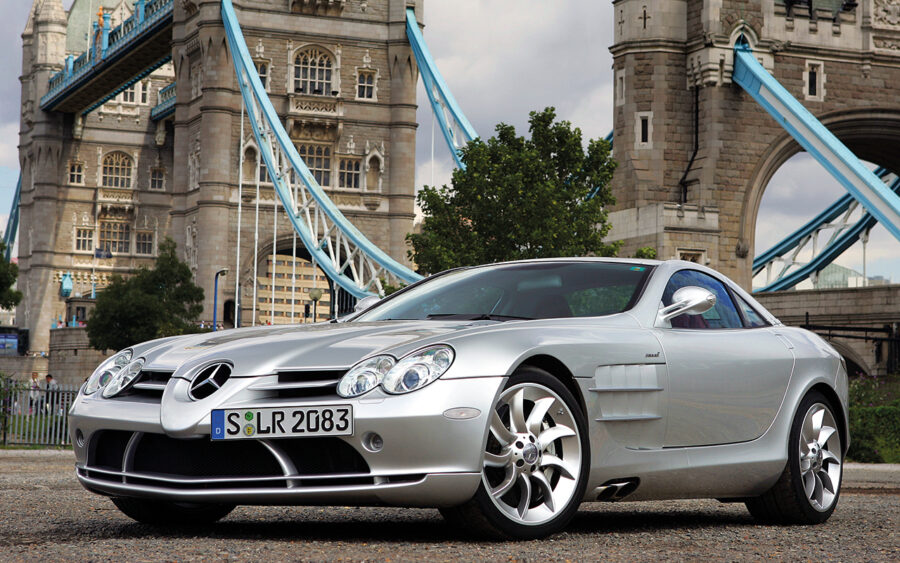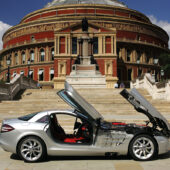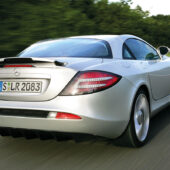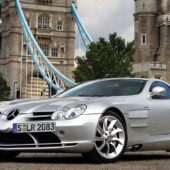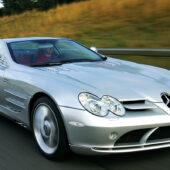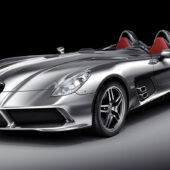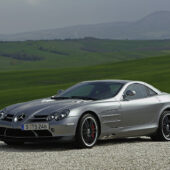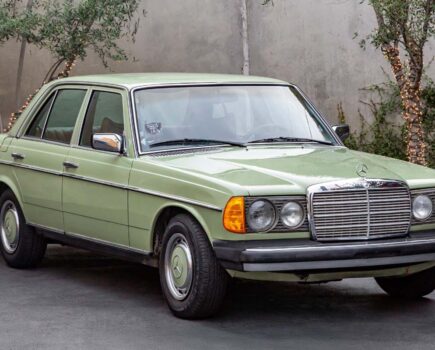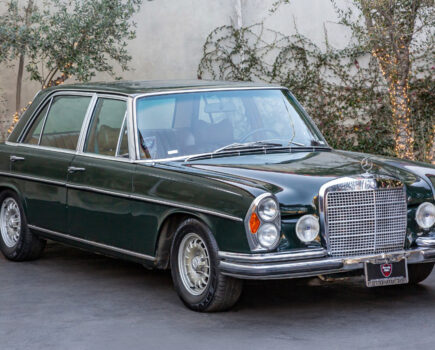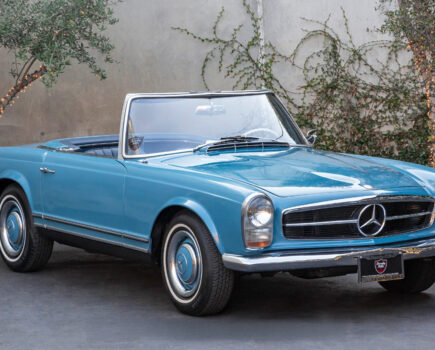McLaren and Mercedes celebrated their first joint Formula 1 Constructors’ Championship with the tour-de-force SLR. Here’s the full story
Words: Craig Cheetham Images: Mercedes-Benz
The SLR nameplate is one steeped in Mercedes-Benz history. The moniker was that of the famous Silver Arrow racing cars of the 1950s piloted in iconic races such as the Mille Miglia and Le Mans by some of the biggest names in motorsport, such as Juan Manual Fangio and Sir Stirling Moss.
Heritage doesn’t come much better than that, so when Mercedes and McLaren decided to celebrate their Formula 1 achievements with a road car, there was only one name for it. Standing for ‘Sport, Leicht, Rennsport’ (‘Sport, Lightweight, Racing’), the name reflected the nature of the firm’s collaborative effort – to a degree at least.
Hot on the heels of winning both the F1 driver’s (thanks to Mika Hakkinen) and constructors’ championships in 1998, Mercedes teased the world with its vision of a 21st century SLR at the North American Auto Show in Detroit, revealed in the first week of January 1999.
The concept car had a distinctive F1-inspired V-shaped nose cone, twin aerofoils, scissor doors, side exit exhausts (a nod to the 1955 SLR) and a huge bonnet, which was more than long enough to accommodate the 5.5-litre AMG V8 engine, leading some pundits to suggest that a V12 could also be on the cards should the car ever reach production.
The chassis was made from composite carbon fibre and extruded aluminium to keep weight down, along with a number of concept features such as its Sensotronic Brake Control (SBC) – an electrohydraulic brake system that would debut later in the roadgoing 2001 SL – and bi-xenon headlamps with Active Light System that used intelligent beam patterns to maximise visibility without blinding oncoming motorists. Later the same year, Mercedes showed a Vision SLR Roadster Concept at the Frankfurt Motor Show.
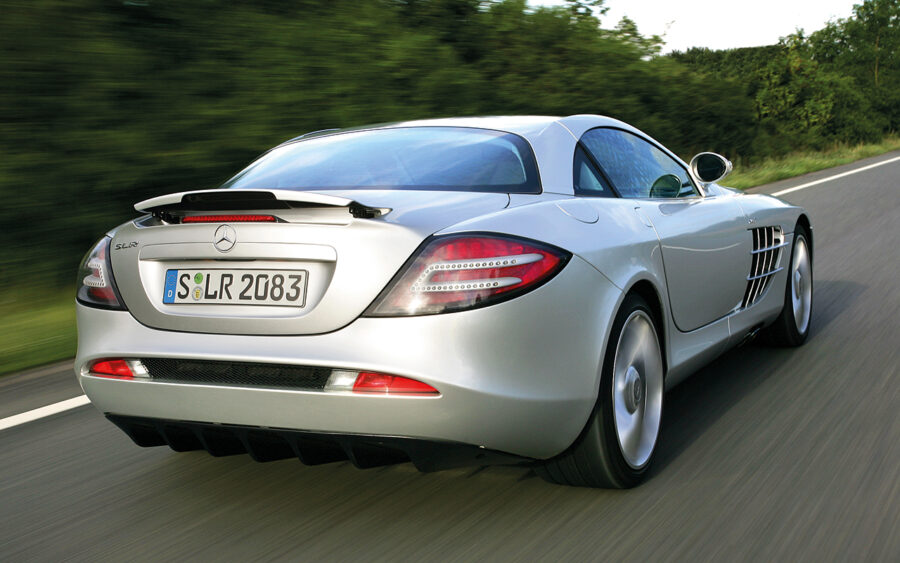
Both coupe and roadster versions of the SLR would ultimately become production cars, but the wait was long; the finished car looked little different to the concept, but production didn’t begin until 2003. All cars were finished at the McLaren Technology Centre in Woking, Surrey, with the powertrains imported from Germany.
As per the concept, the production car had a 5.5-litre AMG V8 equipped with a supercharger (or Kompressor, in Mercedes speak). It developed a whopping 626PS (617bhp) and 780Nm of torque, fed to the rear wheels by a fairly straightforward five-speed automatic transmission with touch-speed control. It could accelerate from 0-62mph in a claimed 3.8 seconds (although several contemporary road testers were able to beat this), with a top speed of 207mph.
All that performance was kept in check by unique carbon-ceramic brakes, along with an adaptable spoiler, which would alter its profile to an angle of 65 degrees under heavy braking to act as an air brake.
The production car’s body was made out of a composite carbon fibre developed from the same materials as McLaren-Mercedes’ F1 cars, giving it a total kerb weight of just 1,750kg – about the same as a mid-spec Vauxhall Vectra of the era.
Between 2003 and 2006, over 1,100 SLRs were sold globally, with a UK list price of £260,000.
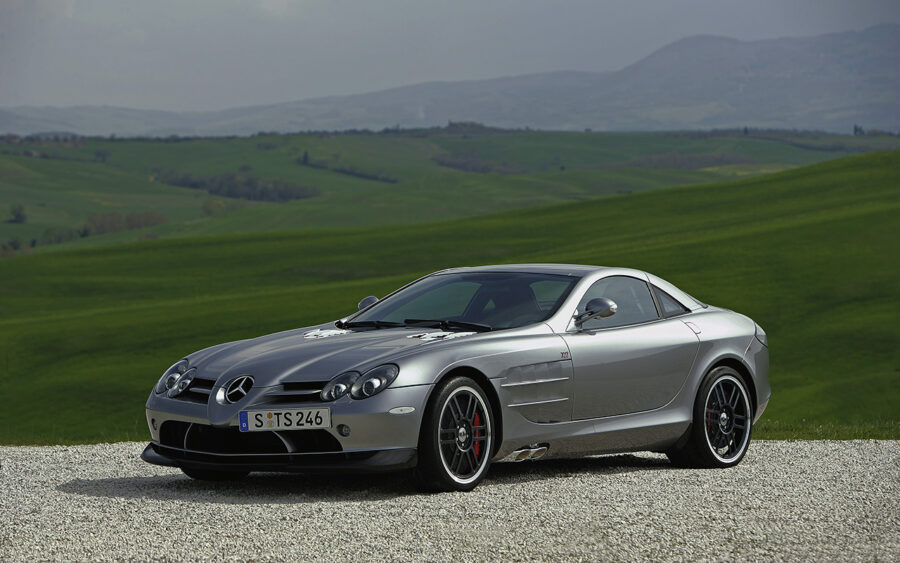
Late in 2006, the SLR was replaced by the SLR 722, which had a power increase to 650PS (641bhp), not 722PS as some believe. Rather, 722 was a tribute to Stirling Moss’ race number in the 1955 Mille Miglia, when the famous driver was just 25 years old. The SLR 722 was marginally quicker than the original, reaching 62mph in 3.6 seconds and a top speed of 209mph. It also gained bigger brakes, using the same carbon-ceramic technology as the original model.
The following year, a whole eight years since it was previewed at the Frankfurt Motor Show, Mercedes revealed a Roadster version of the SLR, which used a lightweight carbon fibre hood frame and chopped-off scissor-style doors.
But the SLR story didn’t end there. In 2008, a one-make race series was commissioned for the car, using engineering company RML Group to build a race-specific model. RML had achieved great successes with MG-Lola at Le Mans, and was also the engine room behind Nissan and Vauxhall’s success in the British Touring Car Championship, as well as taking Chevrolet to victory in World Touring Cars.
The series was targeted at wealthy club racers, with RML redeveloping the suspension, braking system, aerodynamics and interior of the car to make it as lightweight as possible. RML’s engineers shed almost 400kg of weight, resulting in a kerb weight of just over 1,300kg. The GT had 680PS and 830Nm of torque, which enabled the SLR 722 GT to accelerate from standstill to 62mph in 3.3 seconds. A total of 21 cars were built, of which three were destroyed during race meetings.
By 2009, the writing was on the wall for the SLR. The supercar landscape was changing. Features such as launch control, computer controlled adaptable suspension and drive-by-wire technology had made the SLR old hat. But McLaren and Mercedes had one last tribute to pay.

The SLR’s swansong came in the form of the 722 Stirling Moss edition. Designed by stylist Yoon Il-hun, the Stirling Moss was a full open-top, with rollover hoops and no roof or windscreen. It was as pure as a supercar could be, with limited weight and features. With 650PS (641bhp) on tap, it hit 62mph in 3.2 seconds, and had a top speed limited to an eye-watering 220mph. A total of just 75 Stirling Moss editions were made and were offered for sale at an undisclosed price, and only to existing SLR customers.
In 2010, however, McLaren itself revived the SLR. Shown unexpectedly at the 2010 Essen Motor Show, the McLaren edition was the last SLR, with revised bodywork, modified steering and suspension. Only 25 were made, allegedly to complete unfulfilled orders from repeat customers.
When the final SLR rolled off the production line in Woking in 2011, McLaren’s relationship with Mercedes had also come to an end. The divorce was more for economic than acrimonious reasons, but even so there were engineers within McLaren who put their heads above the parapet to suggest that they weren’t entirely happy with the SLR. McLaren’s forte was that of pure-bred sports cars, and the SLR was considered by some to be too much of a grand tourer, despite its blistering performance. In reality, the compromise was such that the SLR was almost viable as a daily driver, at least if you were well-heeled enough to afford one.
Around 2,250 SLRs were made during its production run – two thirds of the volume that Mercedes initially predicted, but still enough to make it one of the best-selling high-end supercars of all time. Indeed, that initial grand tourer/sports car compromise may well have been enough to make it the success that it was.
Most supercars feel like just that – cars designed for a single purpose. That purpose is to go as fast as humanly possible, with maximum drama.
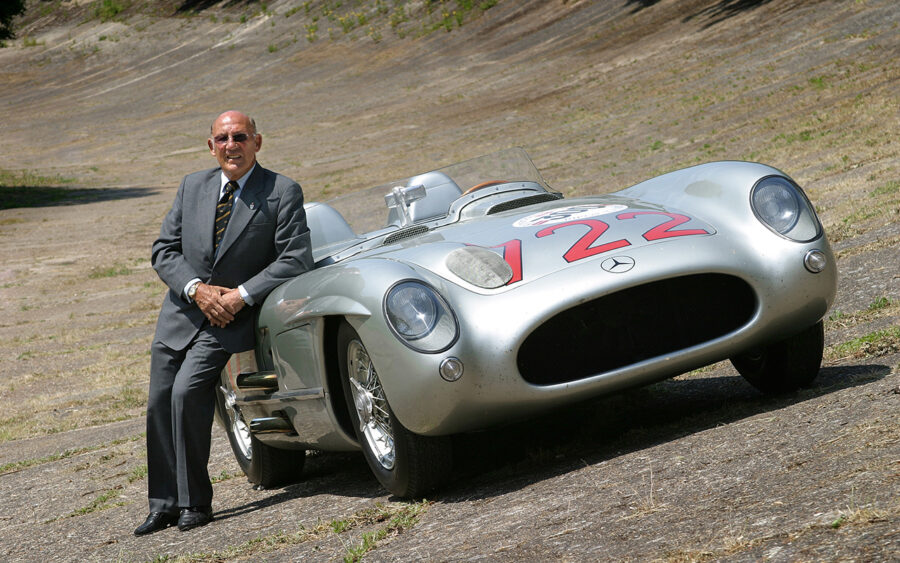
If that’s your desire, then the SLR is at risk of disappointing. Unlike some supercars, you don’t have to contort yourself to get in. The driving position is adjustable and compromise free, to the extent of even being comfortable. Open the scissor doors and you have to step up to get in, but once you’re over the sill structure (essential for the car’s torsional rigidity) there’s plenty of space to adjust your position. Small, tall, fat or thin, you can make the SLR fit you very comfortably, and I say that as a below average-height chubby bloke.
If you’re familiar with any other Mercedes-Benz of the era, the SLR is a comforting place to be. The controls are laid out in the same way as an SL, or even an E or S-Class – enough to make you realise why contemporary road testers may have suggested it lacked a sense of occasion. But that’s unfair.
A nice Mercedes saloon car comes with a sense of occasion. With a strikingly beautiful GT body and a rumbling V8 upfront, it feels like a very special place to be.
Plant the throttle, and it feels even more so. When stationary, a blip of the throttle causes the car to rock gently on its haunches. Release the handbrake, and it lurches forward with alarming alacrity. Drive it hard, and the SLR feels unstoppable, but the brakes are astonishing – even the original car, which didn’t have the upgrades of the 722, will scrub off speed more quickly than you could imagine.
In fairness to the car’s critics, the SLR doesn’t feel as light or as edgy as its contemporaries. You can’t drive it with the same lightness of touch you can apply to a Ferrari, for example, and under hard cornering the limit of adhesion is harder to explore. Whereas a smaller, more agile supercar will warn you when it’s about to come loose, the SLR’s traction control system will kick in long before you think it may be necessary.
To the hardcore enthusiast, then, it isn’t quite the raw experience you might crave. But to the day-to-day user, it’s a phenomenal car. Comfortable, ludicrously quick, astonishing to look at and surprisingly usable. You need deep pockets to run one and even deeper pockets to buy one in the first place – used values currently start at around £300,000 for a standard model – but the SLR is the definitive usable supercar.

